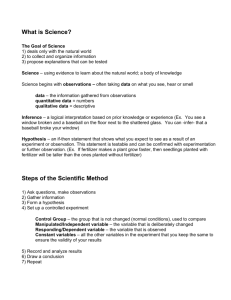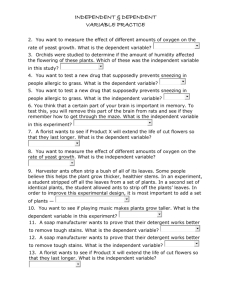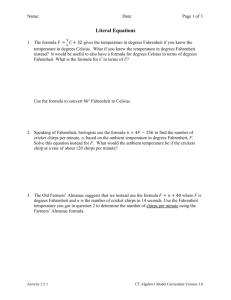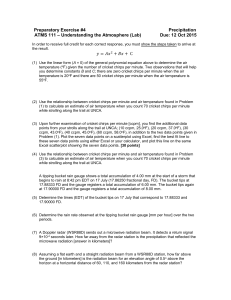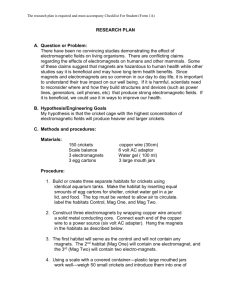Luke Einstein January 17, 2014 St. Luke`s School Science 6 Lab
advertisement
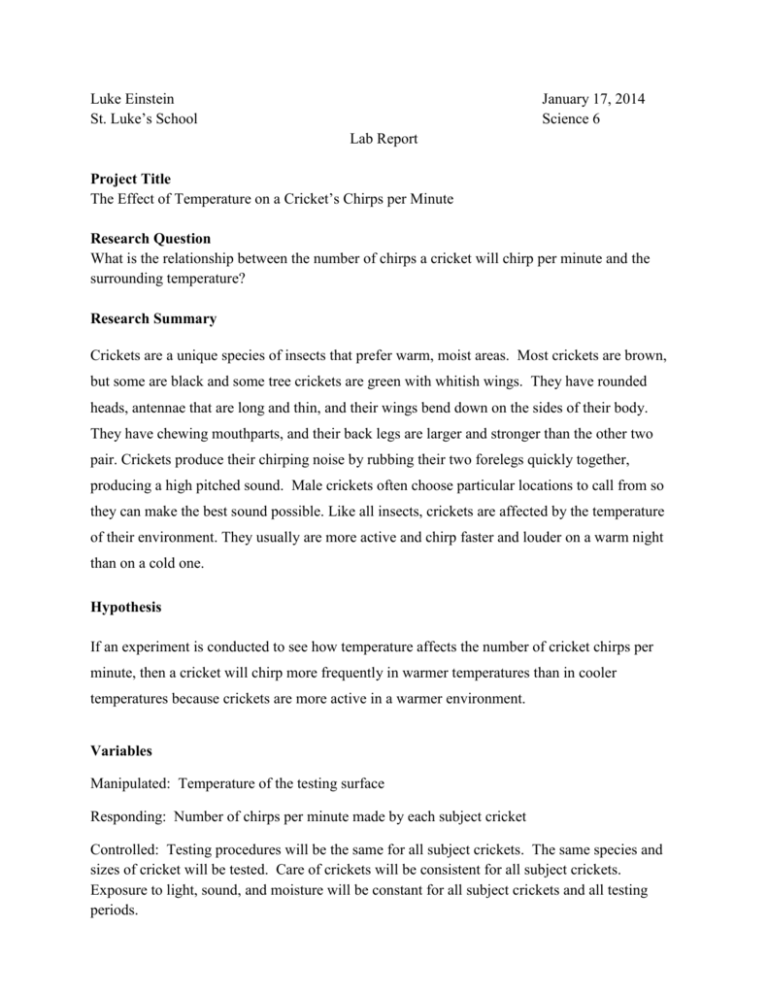
Luke Einstein St. Luke’s School January 17, 2014 Science 6 Lab Report Project Title The Effect of Temperature on a Cricket’s Chirps per Minute Research Question What is the relationship between the number of chirps a cricket will chirp per minute and the surrounding temperature? Research Summary Crickets are a unique species of insects that prefer warm, moist areas. Most crickets are brown, but some are black and some tree crickets are green with whitish wings. They have rounded heads, antennae that are long and thin, and their wings bend down on the sides of their body. They have chewing mouthparts, and their back legs are larger and stronger than the other two pair. Crickets produce their chirping noise by rubbing their two forelegs quickly together, producing a high pitched sound. Male crickets often choose particular locations to call from so they can make the best sound possible. Like all insects, crickets are affected by the temperature of their environment. They usually are more active and chirp faster and louder on a warm night than on a cold one. Hypothesis If an experiment is conducted to see how temperature affects the number of cricket chirps per minute, then a cricket will chirp more frequently in warmer temperatures than in cooler temperatures because crickets are more active in a warmer environment. Variables Manipulated: Temperature of the testing surface Responding: Number of chirps per minute made by each subject cricket Controlled: Testing procedures will be the same for all subject crickets. The same species and sizes of cricket will be tested. Care of crickets will be consistent for all subject crickets. Exposure to light, sound, and moisture will be constant for all subject crickets and all testing periods. Materials 5 live crickets, same species and size 6 cardboard shoe storage boxes with air holes water and plant materials for food heating pad with settings/capability for 15 to 25 degrees Celsius 1 Celsius thermometer 1 timer with seconds notebook and pencil Procedure 1. Gather all materials. 2. Prepare 5 storage boxes for the crickets and place one cricket in each box. 3. Provide the same amount of water and food for each cricket. 4. Place heating pad under the 6th box and set heat setting to 150 C. 5. Place thermometer in bottom of box and wait until it reaches 150 C. 6. Place first cricket in warmed box, wait until it starts chirping, and then set stopwatch to one minute. 7. Count the number of cricket chirps during the one-minute period. 8. Record data on data chart. 9. Repeat the count twice more for the 150 C. setting. 10. Repeat steps 6-9 for each of the five (5) crickets. 11. Set the heating pad to 200 C. and wait until thermometer in box reaches 200 C. 12. Repeat steps 6-10 for the 200 C temperature. 13. Set the heating pad to 250 C and wait until thermometer in box reaches 250 C. 14. Repeat steps 6-10 for the 250 C temperature. 15. Calculate the average number of chirps per minute for each cricket at each of the test temperatures. 16. Calculate the average number of chirps per minute for all crickets combined at each of the test temperatures. 17. Record and analyze data. DATA CHARTS The Relationship of Temperature and Cricket Chirps Per Minute RAW DATA - NUMBER OF CHIRPS PER MINUTE Cricket 15 C. 20 C. 25 C. 1 - Trial 1 93 130 1 - Trial 2 88 135 1 - Trial 3 92 139 AVERAGE 91 135 179 178 182 180 2 - Trial 1 2 - Trial 2 2 - Trial 3 AVERAGE 79 84 78 80 122 125 124 124 175 168 165 169 3 - Trial 1 3 - Trial 2 3 - Trial 3 AVERAGE 85 91 91 89 132 131 128 130 175 178 175 176 4 - Trial 1 4 - Trial 2 4 - Trial 3 AVERAGE 73 75 85 78 125 127 123 125 165 158 152 158 5 - Trial 1 5 - Trial 2 5 - Trial 3 AVERAGE 75 81 76 77 124 131 109 121 165 155 152 157 Cricket 1 2 3 4 5 Average Maximum Minimum AVERAGE NUMBER OF CHIRPS PER MINUTE 15 C. 20 C. 91 135 80 124 89 130 78 125 77 121 15 C. 83 91 77 20 C. 127 135 121 25 C. 180 169 176 158 157 25 C. 168 180 157 Number of Chirps Per Minute Temperature & Cricket Chirps Per Minute 200 180 160 140 120 100 80 60 40 20 0 Average Maximum 15 C. 20 C. 25 C. Average 83 127 168 Maximum 91 135 180 Minimum 77 121 157 Minimum Testing Temperature Number of Chirps Per Minute Temperature & Cricket Chirps Per Minute 200 180 160 140 120 100 80 60 40 20 0 Average Maximum 15 C. 20 C. 25 C. Average 83 127 168 Maximum 91 135 180 Minimum 77 121 157 Testing Temperature Minimum Conclusion The hypothesis that crickets will chirp more frequently at warmer temperatures was supported by the results of this experiment. On average the crickets chirped 83 times per minute at 150 C, 127 times per minute at 200 C, and 168 times per minute at 250 C. The increase in frequency of chirps per minute at the different temperatures remained fairly equal. There was an average increase of 44 more chirps per minute between 150 C and 200 C and 41 more chirps per minute between 200 C and 250 C. Both the raw data and the averaged data support a finding of significance. All crickets increased their number of chirps per minute at each increasing temperature level. The percentage of the increases was 53% from 150 C to 200 C and 32% from 200 C to 250 C. The manipulated variable in this experiment was the different temperature settings and the dependent variable was the number of chirps each cricket made in a timed one-minute period. Maintaining a constant temperature in the testing box was sometimes difficult so as long as the temperature stayed within two degrees Celsius of the intended temperature, the test was included in the results. If the temperature in the testing box changed more than two degrees Celsius higher or lower, the test was not counted. Also, it usually took some time after a cricket was moved into the testing box for the cricket to start chirping so the procedure used was to wait until the cricket started chirping regularly before beginning a trial. These two unexpected variables resulted in having to do many trials to get complete results. Finally, the experiment was started with 12 test crickets, several which didn’t chirp at all and were not included in the testing. So, the results reflect the chirping behavior of only those crickets who were regularly chirping. This experiment could be improved by using more test crickets, including ones that were not regular chirpers. This would probably decrease the average recorded numbers of chirps at different temperatures but it is hypothesized that the number of chirps per minute would still increase as the test temperature increased. The experiment could also be strengthened by adding more test temperatures and trials, especially a lower one of 100 C, and one higher at 300 C. It would be interesting to see at what higher temperature the number of chirps might actually decrease; although it would be important not to harm the crickets with excessive heat. Finally, other variables such as light, noise, and moisture could be tested for their possible effects on a cricket’s number of chirps per minute. The first and most interesting thing I learned about crickets is that the chirping sound they make is produced by them rubbing their legs together and not by their mouths. I also learned that temperature does affect how much a cricket chirps. I know that other factors such as the amount of light, noise, and moisture may also have an impact on crickets’ chirping rates. It was very interesting and challenging to do an experiment with a living organism. The crickets did not always behave the way I expected or needed them to do for the experiment so I had to do many trials to get data that I could use. I learned how important it is to try to control all the variables that could affect the results of an experiment. I know that more trials and the testing of other variables could improve this and other experiments.
